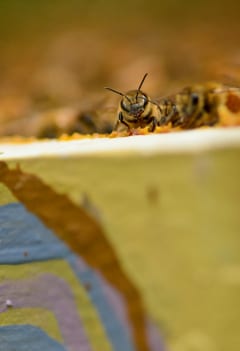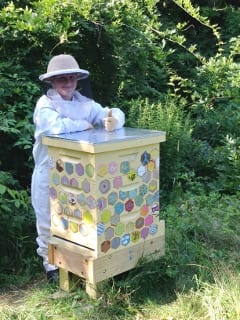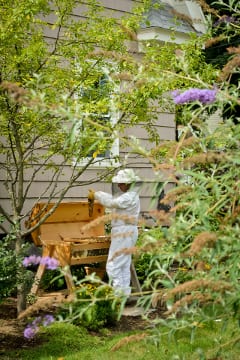by Michelle, Ray, and Sebastian Wright
“Telling the Bees” is a beautiful, old English country tradition. In the 1800s, honeybees were an integral part of family and community landscapes. Informing the family beehive of changes such as a birth, death, or marriage was customary – and if the owner of the hive died, the bees had to be told of the death or they would leave the hive. Not only did backyard hives invigorate garden productivity and provide a bounty of honey, but the family apiary was considered a quiet sanctuary in which to meditate, read, and unwind from the day.
Like so many customs, interest in “talking to the bees” waned over time, and the close relationship we once had with bees has changed. Urbanization and industrialization have, to a great extent, eliminated the need and interest to grow produce at home and shifted the way we think about pollinators. Bees in general have become something to be wary of and even to eradicate from our manicured lawns and gardens.
Bees…and Agriculture…at Risk
This general fear of bees has had a significant impact on both the bee population and on our sustainable agriculture. Since 1945 the population of domesticated honeybees in the United States has declined by over 55% for a wide variety of reasons including broad use of insecticides, pesticides, and monoculture practices. Feral bees have also been declining in many places for some of the same reasons. Without collective intervention, we will lose the vitality in our food supply and our honey bees entirely. That would represent an ecological disaster on a grand scale when you consider that one out of every three bites of the food we eat depends on bees and similar pollinators.
As food and nutrition trends shift back to the land, integrating edible gardens into landscapes is gaining traction. Inviting bees back to our landscapes is a win-win for all. Ecological professionals can be powerful allies – and who better to “tell the bees” that we care and need them more than ever!
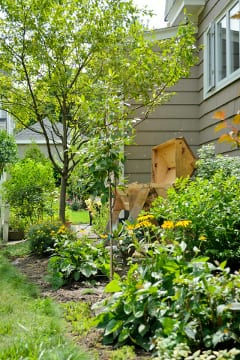
This Frothingham garden hosts a seasoned Top Bar hive and boasts bee-friendly fruit trees, berries, native plants, flowering vegetables and herbs. Photo by Christophe Perez
Planting for Bees
Of course, not everyone has the time or the space to keep bees. However, it’s perfectly possible to improve pollination by making a few conscious choices. Honeybees make up to 300 flights per day to collect nectar and pollen over a three mile radius so planting native species and flowering fruits, vegetables, and herbs that attract, feed, and help pollinators reproduce is a major first step. Plant clustering and color are also key. Yellow, blue, purple, and white blossoms are incredibly eye-catching to bees. They feed on one variety at time so planting three to four bunches of one type of blossom makes foraging more efficient – and although we personally love double blooming flowers, those with single blooms produce more nectar and the pollen is easier for bees to access.
In addition to having bee-friendly plants, an equally important factor in helping bees survive is to create self-sustainable environments that can thrive without the use of chemical fertilizers, pesticides, and insecticides. Neonicotinoids, a class of insecticides found in common garden products, are now strongly linked to Colony Collapse Disorder (CCD). Even if used in small doses neonicotinoids affect bees’ ability to fly, navigate, communicate, forage, and fight off hive threatening pests such as moths and mites. To read more about neonicotinoids and organic and biological alternatives see the Xerces Society: http://www.xerces.org/neonicotinoids-and-bees/.
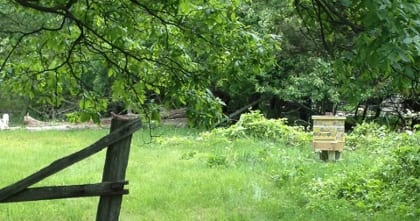
ArtSpace, Milton’s after-school program, painted this colorful Langstroth hive located located in a historical meadow lush with dandelion, clover, wild wisteria, goldenrod, and other flowering weeds. Photo by Christophe Perez
Designing with Hives
For anyone with space and interest in beekeeping, hosting a hive is a fun and fundamental way to help fortify the bee population. There are a variety of attractive hive designs that can be used to add dimension, color, focal point or, appealing barriers to any garden or landscape design. Just as arbors, pathways, and water features can add interest to a landscape design, colorfully painted, attractively designed hives can also be used to engage garden owners and neighbors alike. The most common hive in North America, the box-type Langstroth hive, is often chosen primarily to facilitate honey production – beyond what is needed for the bees. For backyard beekeepers, top bar hives are growing in popularity due to natural – foundationless combs, simplicity, viewing windows and ease of access. There are several other designs to explore including Warre hives and domed basket Skeps.
Apart from being a local source of pollinators, there are many magical products of the hive: honey, wax, pollen, propolis, royal jelly, etc. All are essential for healthy bee nutrition and brood development and the extraction of any by-products must be done in moderation and with great care to prevent harm to the hive.
Other Important Considerations
Beekeeping (or just attracting bees) is not for everyone. Being a spectator – participant observer – closely watching bees as they forage from flower to flower and listening to the hum of the hive is completely safe and beautiful. The risk of a sting from bees in your garden is very small; fears can often be dispelled quite effectively with a little education. Female honeybees, the ones who can sting, may become defensive when you come too near the hive. These are called “guard bees” and that’s their job, to protect hive and brood. For wary neighbors, we’ve eased their fears by inviting them over to observe our top bar hive, participate in an installation, host a leisurely honey tasting afternoon or summer hive dive where we field questions around the apiary and sample honey from a brimming comb.
The origin of the bees and the apiary location can have a big impact on acceptance as well. Some bee species are known to be more aggressive while others, such as Italian bees, are considered far more docile. In general, these latter bees do their best to avoid conflict unless their hive is disturbed. If possible, look for a location that has full sun and place the hive entrance facing south-east (in northern climates). Hives are also best elevated off of the ground and near a water source preferably with some organic matter in it. A farm pond, creek, stream, stock tank, or even a goldfish pond will give bees access to the water they need.
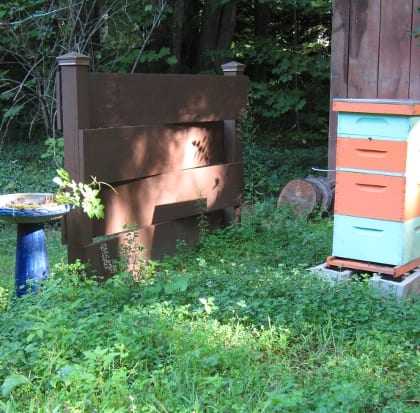
A moss-lined bird bath offers a water source for the bees in this Langstroth hive and a windbreak protects the hive from wind. Photo by Penny Lewis
Honeybees are active from sunrise to sunset, so maximum sun exposure will ensure they’re busy bees – and busy bees make lots of honey! The bees’ flight path will usually take them a short horizontal distance, a few feet from the entrance and then straight up and away. Even though bees like sun they also need protection from the wind. Christy Hemingway, author of The Thinking Beekeeper and owner of Gold Star Honey refers to “wind and cold” as “four-letter words.” Strong, cold winds can be draining and debilitating for bees. For protection you can locate the hives close to a building or a few feet from a fence row or line of trees, otherwise you can build a windbreak.
Milton’s Billion Backyard Bee Project
One of the biggest benefits of an edible landscape is surely the sharing of the harvest with family and friends. Integrating an apiary into the landscape adds another ecological dimension entirely. At first, it’s just a nice spot to visit. Then, after a while, it becomes a necessary part of your life. It’s time to rekindle our relationship with the bees and not only tell them but show them we care. However bees can’t keep a secret; when they find a “home sweet home,” they’re likely to tell the birds and the butterflies too!
About the Authors
Michelle, Ray, and their 10 year-old beekeeper son, Sebastian Wright host two Topbar and two Langstroth hives in Milton, MA. With the help of his parents and several local supporters, Beekeeper Seb has launched his own bee effort, Milton’s Billion Backyard Bee Project, to encourage bee-conservation and backyard beekeeping. To learn more about Beekeeper Seb and his bees check out https://www.facebook.com/miltonbillionbees. He hopes families in neighboring towns will be so excited to learn more about bees that

